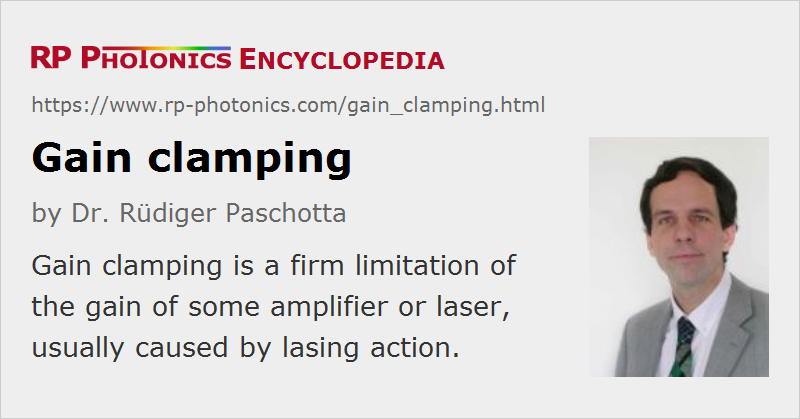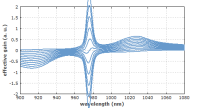Gain Clamping
Definition: a firm limitation of the gain of some amplifier or laser, usually caused by lasing action
German: Verstärkungs-Begrenzung
Categories: lasers, optical amplifiers
How to cite the article; suggest additional literature
Author: Dr. Rüdiger Paschotta
When the (optical or electrical) pump power of a laser gain medium is increased, this will usually lead to an increase in the resulting optical gain. However, there are situations where the gain is firmly clamped to some precisely defined value which cannot be exceeded even with strongly increased pump powers. In particular, this is the case when laser action occurs. The gain is then clamped exactly to the value of the optical resonator losses; any increase of gain would lead to an exponentially rising laser power, which is obviously not consistent with steady-state conditions. Note that this mechanism leads to a much more precisely defined gain than e.g. saturation of the gain for high pump powers.
In lasers and amplifiers (e.g. fiber amplifiers), gain clamping limits not only the optical gain but also the (spatially integrated) excitation density (upper-state population). In turn, this also limits the stored energy and the strength of other effects such as quenching processes or excited-state absorption.
Gain clamping is sometimes exploited in fiber amplifiers for stabilization of the optical gain [1, 2]. Here, lasing is deliberately allowed at some wavelength outside the range of signal wavelengths; this can be achieved by incorporating fiber Bragg gratings into the device. Fluctuations of the pump or signal power will then have only a small effect. Note, however, that gain clamping stabilizes only the steady-state gain; transient phenomena can still occur, for example for fast changes of pump or signal input power.
Of course, gain clamping can also occur in a high-gain amplifier as a result of unwanted parasitic lasing. Stimulated Brillouin scattering can also lead to gain clamping.
Questions and Comments from Users
Here you can submit questions and comments. As far as they get accepted by the author, they will appear above this paragraph together with the author’s answer. The author will decide on acceptance based on certain criteria. Essentially, the issue must be of sufficiently broad interest.
Please do not enter personal data here; we would otherwise delete it soon. (See also our privacy declaration.) If you wish to receive personal feedback or consultancy from the author, please contact him e.g. via e-mail.
By submitting the information, you give your consent to the potential publication of your inputs on our website according to our rules. (If you later retract your consent, we will delete those inputs.) As your inputs are first reviewed by the author, they may be published with some delay.
Bibliography
| [1] | M. Zirngibl, “Gain control in erbium-doped fibre amplifiers by an all optical feed back loop”, Electron. Lett. 27 (7), 560 (1991), doi:10.1049/el:19910353 |
| [2] | H. Okamura, “Automatic optical loss compensation with Erbium-doped fiber amplifier”, IEEE J. Lightwave Technol. 10 (8), 1110 (1992), doi:10.1109/50.156852 |
| [3] | Y. Takushima and K. Kikuchi, “Gain spectrum equalization of all-optical gain-clamped erbium-doped fiber amplifier”, IEEE Photon. Technol. Lett. 11 (2), 176 (1999), doi:10.1109/68.740695 |
See also: optical amplifiers, fiber amplifiers, lasers, gain, gain media
and other articles in the categories lasers, optical amplifiers
 |







If you like this page, please share the link with your friends and colleagues, e.g. via social media:
These sharing buttons are implemented in a privacy-friendly way!